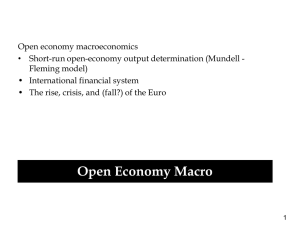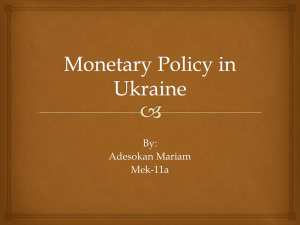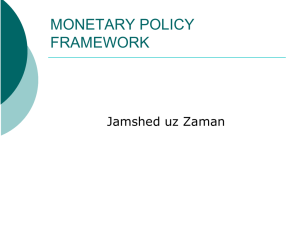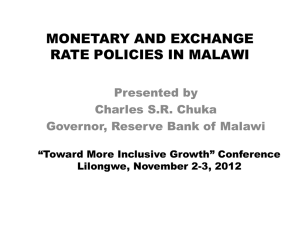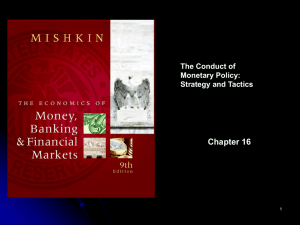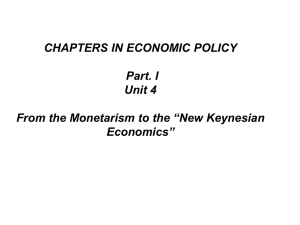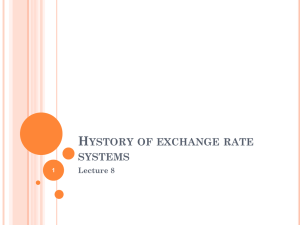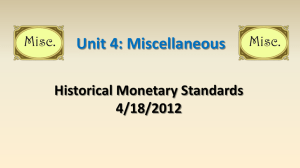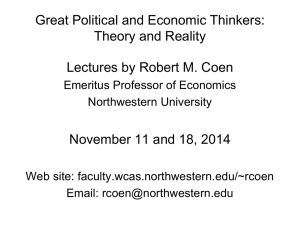Ch 14
advertisement
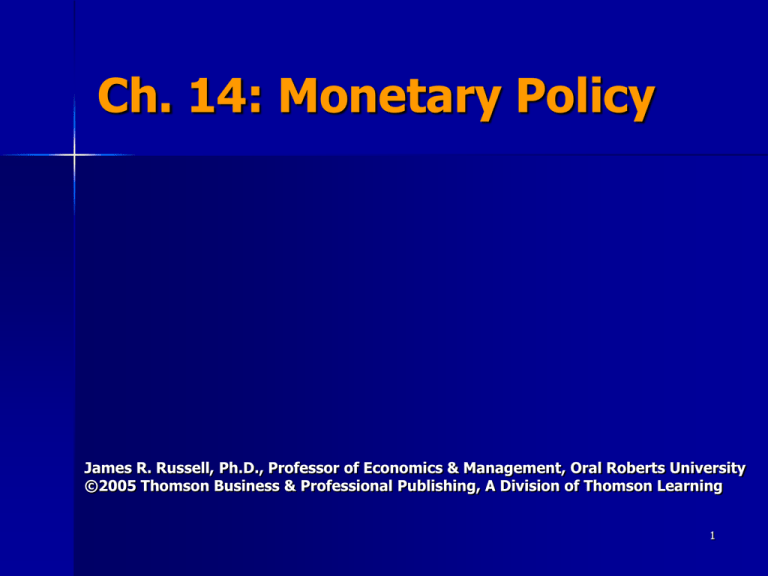
Ch. 14: Monetary Policy James R. Russell, Ph.D., Professor of Economics & Management, Oral Roberts University ©2005 Thomson Business & Professional Publishing, A Division of Thomson Learning 1 The Money Market The Demand for Money Demand for Money (Balances): represents the inverse relationship between the quantity demanded of money balances and the price of holding money balances. The price of holding money balances is the interest rate. The interest rate is the opportunity cost of holding money. As the interest rate increases, the opportunity cost of holding money increases, and people choose to hold less. 2 The Money Market The Supply of Money Perfectly Inelastic (Vertical). Determined largely by the Fed. Banks and the public are also important players. 3 Exhibit 1: The Demand for and Supply of Money 4 Equilibrium in The Money Market Occurs when quantity demanded equals quantity supplied. No shortages (excess demand). No surpluses (excess supply). 5 Exhibit 2: Equilibrium in the Money Market 6 Transmission Mechanism The routes or channels that ripple effects created in the money market travel to affect the goods and services market (represented by the aggregate demand and supply curves in the AD-AS framework). 7 The Keynesian Transmission Mechanism The Money Market The Investment Goods Market The Goods and Services Market (AD-AS Framework) Keynesian transmission mechanism: – an increase in the money supply – lowers the interest rate – which causes investment to rise and the AD curve to shift rightward – Real GDP increases and the unemployment rate drops. 8 Exhibit 3: The Keynesian Transmission Mechanism 9 The Keynesian Mechanism May Get Blocked Interest-Insensitive Investment: other factors involved in making investment decisions. Liquidity Trap: – Horizontal portion of the demand curve for money. – Interest rates have become so low that many believe they have bottomed or are close to bottoming. 10 Exhibit 4: Breaking the Link between the Money Market and the Goods and Services Market: Interest-Insensitive Investment and the Liquidity Trap 11 Bond Prices and Interest Rates The market interest rate is inversely related to the price of existing bonds. Consider the Liquidity Trap: the reason an increase in the money supply does not result in an excess supply of money at a low interest rate is that individuals believe bond prices are so high that an investment in bonds is likely to turn out to be a bad deal. 12 Exhibit 5: The Keynesian View of Monetary Policy 13 The Monetarist Transmission Mechanism: Direct Increase in the money supply – increased Aggregate Demand – increased Real GDP – increased prices – a decrease in unemployment. A decrease in the money supply – decreased Aggregate Demand – decreased Real GDP – decreased prices – an increase in unemployment. 14 Exhibit 6: The Monetarist Transmission Mechanism 15 Self-Test Explain the inverse relationship between bond prices and interest rates. “According to the Keynesian transmission mechanism, as the money supply rises, there is a direct impact on the goods and services market.” Do you agree or disagree with this statement. Explain your answer. Explain how the monetarist transmission mechanism works when the money supply rises. 16 Exhibit 7: Monetary Policy and a Recessionary Gap 17 Exhibit 8: Monetary Policy and an Inflationary Gap 18 Monetary Policy and the Activist–Nonactivist Debate Activists: argue that monetary and fiscal policies should be deliberately used to smooth out the business cycle. Nonactivists: argue against the deliberate use of fiscal and monetary policies. They believe in a permanent, stable, rules-oriented monetary and fiscal framework. 19 The Case for Activist (or Discretionary) Monetary Policy 1. 2. 3. The economy does not always equilibrate quickly enough at Natural Real GDP. Activist monetary policy works; it is effective at smoothing out the business cycle. Activist monetary policy is flexible; nonactivist (rules-based) monetary policyis not. 20 The Case for Nonactivist (or rules-based) Monetary Policy 1. 2. 3. In modern economies, wages and prices are sufficiently flexible to allow the economy to equilibrate at reasonable speed at Natural Real GDP. Activist monetary policies may not work (Exhibit 9). Activist monetary policies are likely to be destabilizing rather than stabilizing; they are likely to make matters worse rather than better (Exhibit 10). 21 Exhibit 9: Expansionary Monetary Policy and No Change in Real GDP 22 Exhibit 10: Monetary Policy May Destabilize the Economy 23 Self-Test Why are Keynesians more likely to advocate expansionary monetary policy to eliminate a recessionary gap than contractionary monetary policy to eliminate an inflationary gap? How might monetary policy destabilize the economy? If the economy is stuck in a recessionary gap, does this make the case for activist monetary policy stronger or weaker? Explain your answer. 24 Nonactivist Monetary (rules –based) Proposals Constant-Money-Growth-Rate Rule: the annual money supply growth rate will be constant at the average annual growth rate of Real GDP. Predetermined-Money-Growth-Rate Rule: the annual growth rate in the money supply will be equal to the average annual growth rate in Real GDP minus the growth rate in velocity. 25 Middle-Ground Monetary Proposals (Taylor Rule) Monetary authorities should use a rule in making discretionary decisions. Federal funds rate target = inflation + equilibrium real federal funds rate + ½(inflation gap) + ½ (output gap) – Inflation: current inflation rate. – Equilibrium real federal funds rate: nominal federal funds rate adjusted for inflation – Inflation gap: the difference between the actual inflation rate and the target inflation rate – Output gap: percentage difference between actual Real GDP and its full-employment level. 26 Self-Test Would a monetary rule produce price stability? 27 Coming Up (Ch. 15): Expectations Theory and the Economy 28

